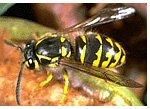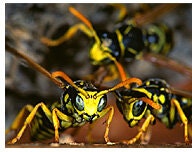Wasps
Yellowjackets and hornets are made up of several species of wasps in the genera Vespula and Dolichovespula. These different species build nests in vastly different places. Vespula pensylvanica is a ground nesting species, often called the meat bee. Vespula vulgaris commonly builds its nests in rotting tree stumps in higher elevations. Vulgaris germanica is found frequently in urban areas, sometimes nesting in houses. Dolichovespula maculata, the bald-faced hornet, builds paper nests attaching them to eaves of buildings or limbs of a tree. Colonies of these species reach much higher numbers than the paper wasps. They can achieve populations between 1,500 and 15,000.
Yellowjackets and hornets get involved with human activity, as they are attracted to some of the same kind of foods humans are. Other meetings can occur when people inadvertently disturb a ground nest or nest in a wall or tree. Yellowjackets and wasp are most problematic in the late summer or fall, when colonies reach their highest numbers. In Butte County, they usually involve one of five species: Vespula pensylvanica, Vespula vulgaris, Vulgaris germanica, Dolichovespula arenaria or Dolichovespula maculata. The first two are by far the most common in the Butte County area, and the third has appeared recently from the eastern US.
The paper wasp is made up of mostly the Polistes genus. They are easy to distinguish from other bees, hornets and yellowjackets as they are less aggressive and they build a hexagonal, open paper nest. Markings and colors vary but include yellows, browns and blacks. The nest is constructed in protected areas above the ground. Common areas their nests can be found include on walls or under eaves of homes and other buildings. Nest construction begins in the spring and construction and maintenance continues as long as the colony continues to grow. Wasps gather fibers from old decaying wood or dead, dry plants, chew them up and mix the debris with water to make their gray paper nest. Populations in these nests rarely ever exceed 200.

Want to Trap?


